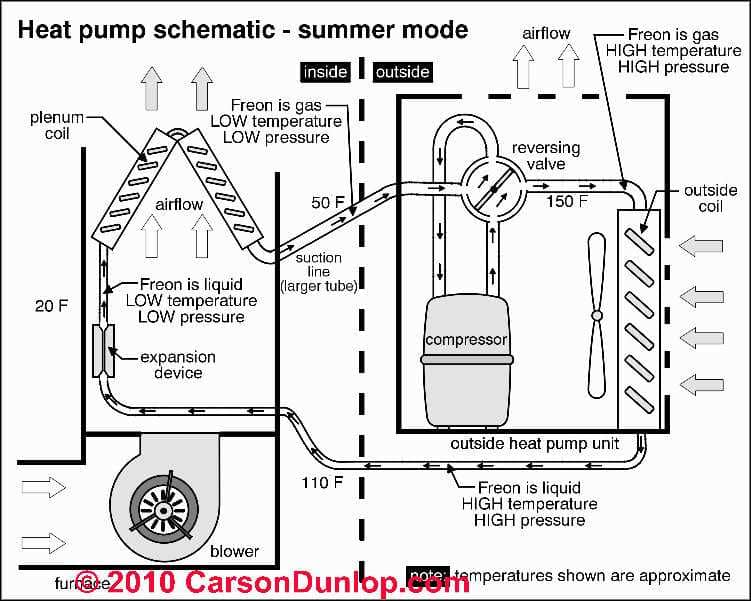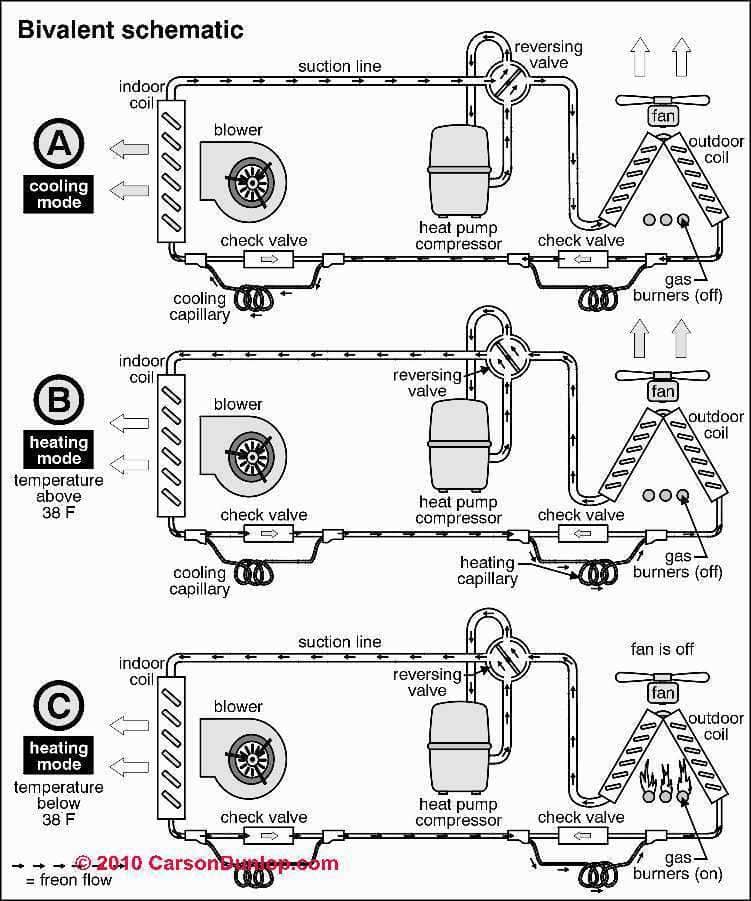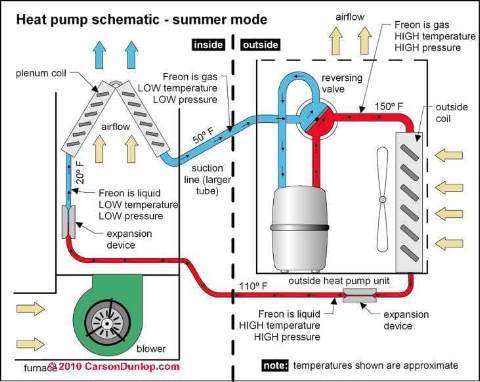 Heat Pumps
Heat Pumps
Heat Pump Types,
Inspection, Diagnosis, Inspection, Repair Guide
If your cooling or heat pump system isn't working, start here.
- POST a QUESTION or COMMENT about how to diagnose & repair residential heat pump systems
Heat pump system inspection, basics of operation, troubleshooting & repair guide. This article series answers most questions about heat pump system troubleshooting, inspection, diagnosis and repair. We explain how heat pumps work to provide cooling in hot weather and heating in cool or cold weather.
We explain the concept of coefficient of performance or COP, and how the COP balance point determines how much use can be made of a heat pump in different climates.
InspectAPedia tolerates no conflicts of interest. We have no relationship with advertisers, products, or services discussed at this website.
- Daniel Friedman, Publisher/Editor/Author - See WHO ARE WE?
Heat Pump System Inspection, Diagnosis, Repair - Troubleshooting & Repair Articles

This article describes how to inspect residential heat pump systems (combination heating and cooling systems) to inform home buyers, owners, and home inspectors of common heat pump system defects.
Article Contents
We explain How a Heat Pump Operates to Extract Heat from Outdoor Air When in Heating Mode = Winter Mode.
We give troubleshooting backup heat problems on heat pump systems that provide both air conditioning and heating.
We describe how to determine heat pump capacity.
What is the COP or Coefficient of Performance of Heat Pumps? What is the COP balance point for heat pump designs? Heat pump system components and parts and a comparison of air, water, and ground source heat pump designs.
How does a Triple Split System Heat Pump System operate?
How does a Bi-Valent Heat Pump System Work?
What are phase change heat pump systems?
What is the difference between single phase vs. three phase electrical power and what does that mean for small vs. large or commercial heat pump systems?
The articles at this website describe the basic components of a heat pump system, how heat pumps are inspected, diagnosed, and repaired, and we discuss how to estimate the rated heating and cooling capacity of a heat pump system by examining various data tags and components.
The limitations of visual inspection of HVAC systems are described as well.
Heat Pump Operating Principles
The schematic of a heat pump system shown above and the sketch at left are compliments of Carson Dunlop Associates, a Toronto home inspection, education & report writing tool company [ carsondunlop.com ].
A "heat pump" is an air conditioning system that can work in either of two directions.
During the cooling season
the heat pump moves heat from inside the building to outdoors by removing heat from indoor air - by blowing indoor air across the evaporating or cooling coil.
During the heating season
the same equipment reverses the direction of its operation, scavenging heat from outdoor air and moving it into the building - by blowing indoor air across a warmed condensing coil, and by blowing outdoor air across the outdoor coil.
Controls in the heat pump reverse the operation and flow of the refrigerant in order to change the direction of heat movement between the indoor and outdoor areas.
Since most components of a heat pump system are identical with those of central air conditioning systems, readers should also be sure to review our air conditioning system inspection, diagnosis, and repair articles.
Below we expand the explanation of how a heat pump works in summer - cooling mode and how a heat pump works in winter - heating mode.
How the Heat Pump Works When in Cooling Mode = Summer Mode
Below we illustrate the heat pump operation when the equipment is in heating mode.
In cooling mode the heat pump works like a conventional air conditioner. The indoor cooling coil expands liquid refrigerant into a gas form, cooling the coil. Indoor air is cooled by being blown across the indoor cooling coil (left side of the Carson Dunlop Associates' image).
Outside the refrigerant gas is compressed to high pressure high temperature gas, then sent through the outdoor condensing coil where outdoor air blown across the condensing coil condenses the refrigerant back to a liquid for its return to the indoor components.
Even though the outdoor air may be hot during the cooling season, it is at a lower temperature than the outdoor condensing coil - so the system works to transfer heat from indoors to outside.
See the next two illustrations for more detail about this process when we switch to heating mode.
How a Heat Pump Operates to Extract Heat from Outdoor Air When in Heating Mode = Winter Mode
Illustrations above & below provided by Carson Dunlop Associates, a Toronto home inspection, education & report writing tool company [ carsondunlop.com ].
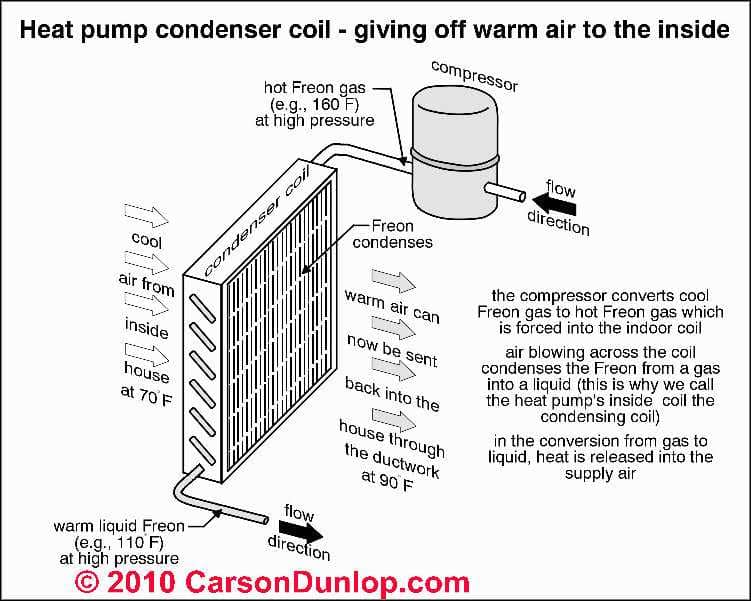
Additional Controls for a Heat Pump
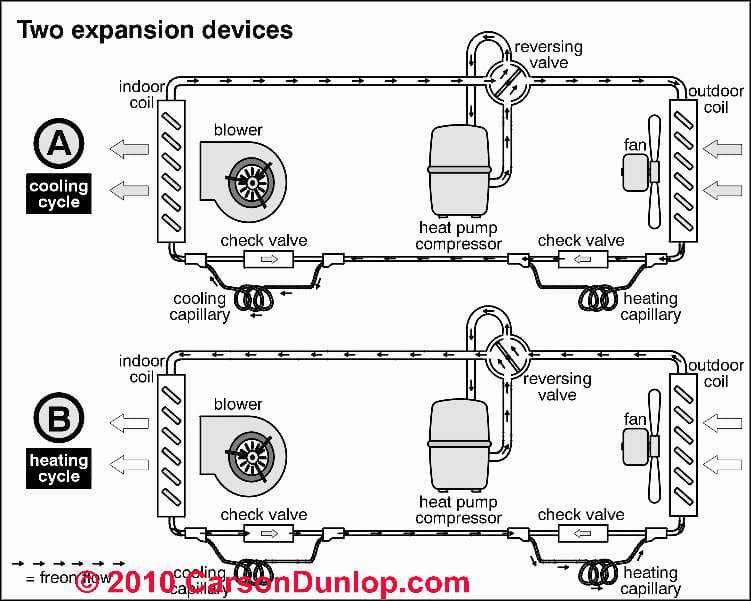
We have said often that a heat pump is pretty much like an air conditioner, with a few control differences to allow the system to reverse its direction of heat movement between the indoor and outdoor areas.
In an air conditioner the outdoor coil is used only to cool and condense high temperature high pressure refrigerant gas back to a liquid refrigerant, and the indoor coil is used only to expand the liquid refrigerant to a gas (through an expansion device such as a Thermostatic Expansion Valve (TEV) or a capillary tube (Cap Tube).
But because a heat pump has to be able to work in both directions, its indoor and outdoor coil have to be able to exchange roles. To accomplish this the heat pump will need two refrigerant metering and expansion devices, one at each coil.
Only one of the expansion devices is operating at a given time - depending on whether the equipment is operating in a heating or in a cooling mode.
Illustration provided by Carson Dunlop Associates, a Toronto home inspection, education & report writing tool company [ carsondunlop.com ].
Reversing Valve and Defrost Cycle Operation Procedure for Heat Pumps

In addition to the two expansion devices, the system may make use of a reversing valve that changes the direction of flow of refrigerant gas and liquid in the system.
An additional set of controls for operation the refrigerant reversing valve and the operation of the defrost cycle for a heat pump are illustrated at left. During a defrost cycle
- The reversing valve changes direction of the refrigerant flow to send warmed refrigerant "freon" to the outdoor coil in order to melt ice that may have formed there.
- During the defrost cycle the outdoor fan stops - we want to stop moving outdoor air across the outdoor coil in order to allow the warm refrigerant to warm the coil.
- If the system includes electric heating elements, one stage of the electric
BACKUP HEAT for HEAT PUMPS
may be activated in the blower compartment to warm air coming off of the blower.
If the system does not include electric backup heaters, the indoor air handler blower will stop during the defrost cycle so that we don't' blow wrong-temperature air into the occupied space.
Illustration provided by Carson Dunlop Associates, a Toronto home inspection, education & report writing tool company [ carsondunlop.com ].
Details about reversing valves are found at REVERSING VALVE on HEAT PUMPS
"All Electric" Heat Pump System Compared with Gas or Oil Backup Heat

The operation of the outdoor compressor/condenser unit and the indoor air handler blower assembly unit is normally run by electrical power.
When the back-up heat for a heat pump operated building is also all electric we refer to the installation as an all-electric heat pump installation. All electric heat pump systems are suitable where electrical energy costs are low or where the number of heating degree days in the local climate is modest.
See BACKUP HEAT for HEAT PUMPS for a discussion of how a heat pump electric backup heat system is tested.
For locations subject to very cold winter weather with many heating days during which outdoor temperatures are below the balance point for heat pump operation, building owners typically use a fossil-fuel backup heat such as natural gas, propane, or heating oil, and may heat by an integrated furnace or by a separate heating system.
Illustration provided by Carson Dunlop Associates, a Toronto home inspection, education & report writing tool company [ carsondunlop.com ].
How does a Water Source Heat Pump System Work?
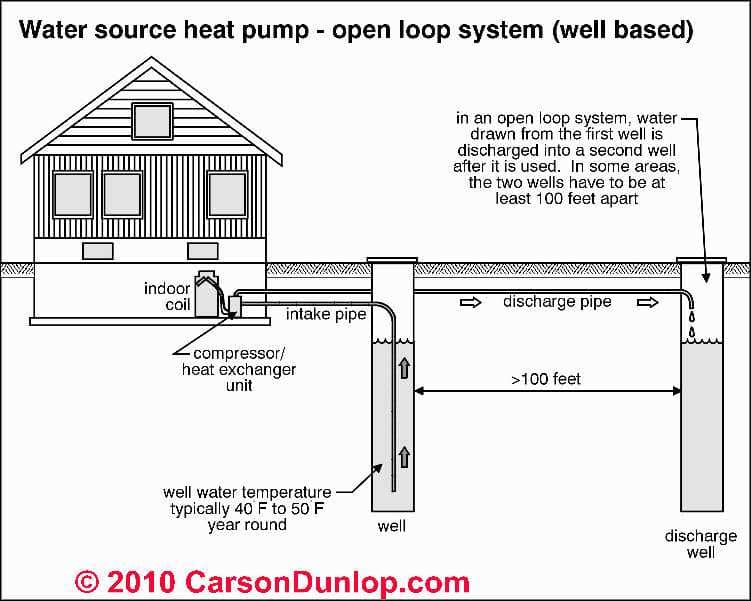
The operation of a water source heat pump system depends on accomplishing its temperature change by using water from a well, or more generally from a pair of wells.
Some water source heat pumps use one or a cascade of water storage tanks. In a water storage tank design, well water is pumped into the storage tank and the heat pump continues to pump heat into the water or take heat from the water (depending on summer or winter mode operation) until the temperature of the water no longer permits an efficient energy exchange.
At that point the energy exchange available in the tank of water has been exhausted - the tank is pumped back into a discharge well, or in some older designs, into another destination.
More details about measuring the efficiency or COP and EER of ground water heat pumps are found
Illustration provided by Carson Dunlop Associates, a Toronto home inspection, education & report writing tool company [ carsondunlop.com ].
How does a Ground Source Heat Pump System Work?
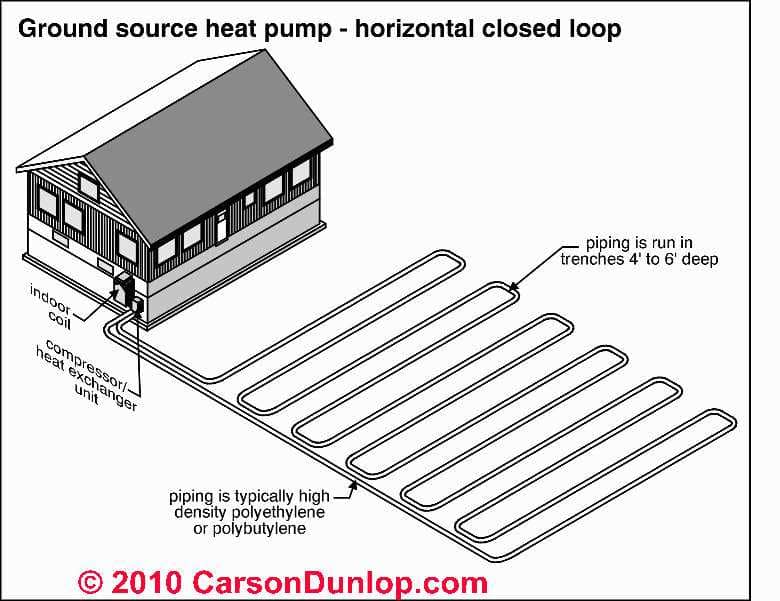
For a simple understanding of all heat pump systems, air, water, or ground-sourced, it helps to understand that we are always moving heat back and forth between the heat pump and the air, water or ground. The differences are in the medium of exchange, not in the basic system operation and controls.
The operation of a ground sourced heat pump system is described by the illustration at left.
Unlike the water based heat pump operation, the ground sourced heat pump system uses a loop of pipes buried in soil to exchange heat with the ground; a separate tank system or discharge well system is not required.
Illustration provided by Carson Dunlop Associates, a Toronto home inspection, education & report writing tool company [ carsondunlop.com ].
Layout of a Triple Split System Heat Pump System
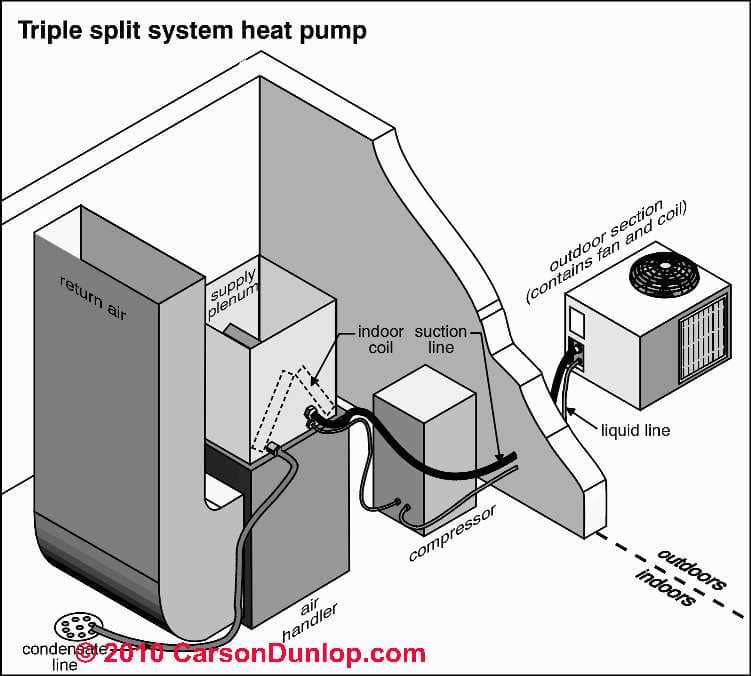
The sketch above illustrates how a triple split system heat pump is organized.
The compressor motor is installed and located as a separate component inside the building while the other system components (outdoor coil and indoor coil) remain in their traditional locations.
Illustration provided by Carson Dunlop Associates, a Toronto home inspection, education & report writing tool company [ carsondunlop.com ].
How does a Bi-Valent Heat Pump System Work? Three Operating Modes all using the outdoor coil
The operation of a bivalent heat pump is not as confusing or intimidating as the name might sound.
A bi-valent heat pump installation adds this term to handle three different heat pump operating conditions:
- Cooling mold -
the system works as the heat pumps described earlier in this article - Heating mode 1.
In moderately-cool outdoor temperature conditions during which the outdoor temperature does not drop below a preset level, typically 38 degF. the heat pump provides heat to the building without resorting to a backup heat system. - Heating mode 2.
In colder outdoor conditions when the outside temperature is below the set point (we're using 38 F.) an auxiliary or backup heating system (such as LP or natural gas burners) operates to warm the outdoor coil that in turn is used to deliver heat to the occupied space.
Illustration provided by Carson Dunlop Associates, a Toronto home inspection, education & report writing tool company [ carsondunlop.com ].
Phased Zone Heat Pump Efficiency vs. Heat Pumps using Single Phase vs. Three Phase Electrical Power
Definition of Phased Zone Heat Pumps
Phased zone heat pumps use phase change materials (PCMs) to store energy either by warming the PCM or cooling it, later retrieving the energy from the same storage cache.
The benefit of a phased zone heat pump system, then, is that by storing extra energy and then retrieving it later when needed, the overall efficiency of the system is increased, and the delivery of heating or cooling is more consistent as outdoor temperature varies through the day. Experts describe phased zone heat pumps as having a higher COP or Coefficient of Performance than a standard heat pump system.
Definition of Single Phase vs Three Phase Heat Pumps
Single phase vs. three phase electric heat pumps refers to the design of heat pumps using two different electrical power types, single phase electrical power (one live electrical wire and one neutral wire) vs. three phase electrical power (three live electrical wire, each delivering alternating current that is 120 electrical degrees apart from the other two), is a completely different topic.
Smaller heat pumps and air conditioners are usually single phase while larger heat pump systems are more-often designed to use three phase electrical power and are more-often commercial heat pumps.
The main advantages of using three phase electrical power for a heat pump are:
- Electrical power to the compressor motor is more consistent in comparison with single phase power that is more vulnerable to voltage fluctuations in the electric company's power line system.
- A three phase electrical power supply is more efficient, able to transmit three times as much power than a single phase or single wire system over the transmission lines.
- For a given amount of electrical power (say measured in watts), a three phase wiring system can deliver that power using less total electrical conductor (wire) material than a single phase wire.
Phased Zone Heat Pump vs. Single vs Three Phase Electrically Powered Heat Pumps Research
- DEFINITION of ELECTRICAL POWER PHASES - Single Phase vs Two vs Three Phase Electrical Power
- ELECTRIC MOTOR: 3-PHASE MOTOR SELECTION
- Fluke, What is the difference between single-phase and three-phase power? [Web article] Fluke Corp., Technical Support: my.fluke.com/en-US/new-request/ Tel: 0044-1603-256613 - retrieved 2025/01/05, local copy saved as Single-vs-Three-Phase-Power-Fluke.pdf
- Sprsun, Single Phase vs. Three-Phase Heat Pumps [Web article] Guangzhou SPRSUN New Energy Technology Development Co., Ltd., Tel: 0086-20-82181867 / 0086-18933985692 - Email: inquiry@sprsunheatpump.com - retrieved 2025/01/05, local copy saved as Single-vs-3-Phase-Heat-Pumps-Sprsun.pdf
What is the COP or Coefficient of Performance of Heat Pumps?
The COP or coefficient of performance describes the ability of a heat pump to extract heat from outdoor air down to some low temperature, typically 25 degF. for modern equipment. The COP determines how effective a heat pump can be at providing heat during cool or cold weather.
Details including a definition of COP, an explanation of the heat pump balance point, and how to calculate heat pump operating cost more accurately by considering degree days are at HEAT PUMP COP - Definition, sources of variation in heat pump operating efficiency & cost
Heat Pump operating cost variables & COP Calculations
Where a heat pump is used to provide part of the building's heat requirements, the efficiency of the air-to-air heat pump will be less at lower temperatures. Spies (1971, 1977) [2] notes that heat pump efficiency when outdoorr air is warm is quite different from at cold temperatures, making its use of electricity more complex.
The coefficient of utilization may be as high as 3.0, falling to 1.0 as outdoor temperature approaches 10 degF. In 1971 when Spies wrote that note for the Small Homes Council, few heat pumps worked at temperatures that low,
Also that this was in 1971, newer equipment is capable of efficient heat extraction from colder air. Spies provided a calculation to transfer heat pump efficiency or COP into electrical costs when comparing heating fuel type cost alternatives:
Table of Electricity Cost Divisors for Heat Pump Operating Cost vs Degree Days - Outdoor Temperature |
|
| Degree Days for Your Location | Electricity Price Divisor |
| 8000 degree-day heating season | 1.4 |
| 6000 degree-day heating season | 1.7 |
| 4000 degree-day heating season | 2.2 |
Notes to the table above
- Henry Spies, "Fuels & Burners", Small Homes Council - Building Research Council Circular Series #G3.5, 1971. 1977
Example: If you live in a climate in which the average number of degree days in the heating season is 4000, then to compare heat pump operating costs (using electricity) to other fuels and heating methods,
divide your current electricity cost (say 5 cents per kwh) by 2.2.
5 / 2.2 = 2.27 cents / kwh
Heat Pump Stopped Heating or Cooling - Diagnostic Guide
If your heat pump system has lost its cooling capacity or won't start select one or more of the diagnostic articles listed below.
- A/C REFRIGERANT LEAK DETECTION: how to use a TIF5000 to detect air conditioning refrigerant gas leak
- A/C DIAGNOSTIC FAQs: air conditioning system diagnostic FAQs: Q&A about air conditioner repair - a detailed air conditioning system diagnostic checklist
- AIR HANDLER UNIT: problems with the air handler, air filters, and the cooling coil itself
- BACKUP HEAT: on heat pumps, types of backup heat; problems with backup heat; begin here if your heat pump is not providing enough heat or if your air conditioning system provides heat when it should be providing cooling.
- COMPRESSOR CONDENSER: problems with air conditioner compressor/condenser units including noises and compressor hard-starting repairs
- A/C - HEAT PUMP CONTROLS & SWITCHES: air conditioner controls and switches - begin here if your A/C won't start.
Here's an important tip: most refrigeration problems, in air conditioners, refrigerators, or freezers, are electrical, not mechanical. In air conditioning school, we used to drive out and collect abandoned refrigerators that people were tossing out during our community's spring cleanup week.
Taking these appliances back into the shop we found that almost always the problem that had caused the owner to dispose of their air conditioner or freezer was in an electrical connection or electrical control. So it's worth checking out switches and controls on an air conditioner before replacing more costly components. - DEHUMIDIFICATION PROBLEMS - Air conditioner cools but does not dehumidify
- DUCT SYSTEM DEFECTS: problems with the air duct system, air filters, supply registers, return air registers
- FIRE DAMPERS, and Heating and Cooling Air Duct Controls such as manual and automatic duct dampers, zone dampers, and fire dampers are discussed and distinguished
at DRAFT REGULATORS - barometric damper - LOST COOLING CAPACITY: what to do when not enough cool air comes out of the system - the articles in this series also assist in diagnosis of lost heating capacity for heat pump systems.
- WHAT TO CHECK FIRST if there is no cool air or not enough cool air
- COMPRESSOR FAILURE DIAGNOSIS basic checks of the air conditioner compressor
- DUCTS & AIR HANDLER DIAGNOSI : basic checks of the indoor air handler (blower), air ducts, and filter system
- OPERATING DEFECTS: major air conditioning problem symptoms and how to get the air conditioning system working again,e.g. compressor or fan noises, failure to start, and inadequate cool air volume
- ZONE DAMPER CONTROLS . discusses manual and automatic air duct zone controls
...
...
Continue reading at DEFECTS LIST - HEAT PUMP or select a topic from the closely-related articles below, or see the complete ARTICLE INDEX.
Or see HEAT PUMP REPAIR FAQs for questions & answers about condensate pump installation, inspection, troubleshooting, & repair and that were posted originally on this page
Or see these
Recommended Articles
- DIAGNOSTIC GUIDE A/C or HEAT PUMP - diagnose air conditioner or heat pump not working
- AIR CONDITIONING & HEAT PUMP SYSTEMS - basic components of air conditioners and heat pumps.
- APPLIANCE EFFICIENCY RATINGS - how efficient is your heat pump? also
- BACKUP HEAT for HEAT PUMPS - types of backup heat, diagnosing back up heat pump heat not working properly
- DEFECTS LIST - HEAT PUMP - inspection education curriculum & defect checklists
- DEFECTS LIST - HEAT PUMP SUBSYS - inspection education curriculum & defect checklists
- HEAT PUMPS, GROUNDWATER - what are the COP's and EER's of groundwater based heat pump systems?
- A/C - HEAT PUMP CONTROLS & SWITCHES - for air conditioning and heat pump systems
- ENERGY USE MONITORING, SOLAR - tracking energy use to see where to save on heating or cooling costs
- HEAT PUMP STRATEGY - Indoors? - can we locate a heat pump or water heating heat pump indoors to scavenge heat?
- HEAT PUMPS, GROUNDWATER - what are the COP's and EER's of groundwater based heat pump systems?
- HEAT PUMPS - home - includes heat pump terms, definitions & terminology
- HEAT PUMP COP
- HEAT PUMP STRATEGY - Indoors? - can we locate a heat pump or water heating heat pump indoors to scavenge heat?
- HEAT PUMP THERMOSTAT, OUTDOOR - failures in an outdoor component can cause odd heat pump operation or noises
- FAN AUTO ON THERMOSTAT SWITCH - make sure it's turned on to the proper setting
- HEAT PUMP THERMOSTAT, OUTDOOR - failures in an outdoor component can cause odd heat pump operation or noises
- LOST COOLING CAPACITY - why are we not getting adequate cooling or heating from our heat pump?
- RATED COOLING CAPACITY
- REVERSING VALVE on HEAT PUMPS
Suggested citation for this web page
HEAT PUMPS at InspectApedia.com - online encyclopedia of building & environmental inspection, testing, diagnosis, repair, & problem prevention advice.
Or see this
INDEX to RELATED ARTICLES: ARTICLE INDEX to AIR CONDITIONING & HEAT PUMPS
Or use the SEARCH BOX found below to Ask a Question or Search InspectApedia
Ask a Question or Search InspectApedia
Try the search box just below, or if you prefer, post a question or comment in the Comments box below and we will respond promptly.
Search the InspectApedia website
Note: appearance of your Comment below may be delayed: if your comment contains an image, photograph, web link, or text that looks to the software as if it might be a web link, your posting will appear after it has been approved by a moderator. Apologies for the delay.
Only one image can be added per comment but you can post as many comments, and therefore images, as you like.
You will not receive a notification when a response to your question has been posted.
Please bookmark this page to make it easy for you to check back for our response.
IF above you see "Comment Form is loading comments..." then COMMENT BOX - countable.ca / bawkbox.com IS NOT WORKING.
In any case you are welcome to send an email directly to us at InspectApedia.com at editor@inspectApedia.com
We'll reply to you directly. Please help us help you by noting, in your email, the URL of the InspectApedia page where you wanted to comment.
Citations & References
In addition to any citations in the article above, a full list is available on request.
- HEAT PUMP GLOSSARY [PDF] courtesy of Greenfoot Energy Solutions, Moncton - 43 Driscoll Crescent, E1E 4C8
Canad, Tel: (506) 383-3446 Email: Web: https://www.greenfootenergy.ca Tel: 1 (844) 213-2471 Website: retrieved 2022/01/18 original source: https://www.greenfootenergy.ca/resources/heat-pump-glossary
Greenfoot Energy Solutions, an energy auditing company advertising the provision of un-biased information, has offices in a numer of Canadian cities. - Thanks to Mark Cramer, Tampa Florida, for assistance in technical review of the "Critical Defects" section and for the photograph of the deteriorating gray Owens Corning flex duct in a hot attic. Mr. Cramer is a Florida home inspector and home inspection educator.
- [2] Henry Spies, "Fuels & Burners", Small Homes Council - Building Research Council Circular Series #G3.5, 1971. 1977 [copy on file as PDF]
- Thanks to Neal Renn who described diagnosing the problem of a heat pump that "only gets backup heat and no cooling" to describe the problem of a heat pump that insists on turning on backup heat when it is not needed.
- Thanks also to Alan Carson, Carson Dunlop, Associates, Toronto, for technical critique and for providing a copy of Carson Dunlop Weldon & AssociatesTechnical Reference Guide to manufacturer's model and serial number information for heating and cooling equipment ($69.00 U.S.).
- Geothermal HVAC, [Amazon.com] Jay Egg & Brian Howard, McGraw-Hill Professional; ISBN-10: 0071746102, ISBN-13: 978-0071746106,
Quoting:
This definitive guide covers commercial and residential geothermal heating, ventilation, and air conditioning technologies and explains how to take advantage of their money- and energy-saving features. Geothermal HVAC: Green Heating and Cooling reviews the array of choices currently available, offers market values for systems based on varying options and conditions, and describes how to pair the best systems for each application and budget. - Geothermal Heat Pumps: A Guide for Planning and Installing, [Amazon.com], Karl Ochsner, Robin Curtis, Earthscan Publications Ltd. (December 2007), ISBN-10: 1844074064, ISBN-13: 978-1844074068
Quoting:
Geothermal Heat Pumps is the most comprehensive guide to the selection, design and installation of geothermal heat pumps available. This leading manual presents the most recent information and market developments in order to put any installer, engineer or architect in the position to design, select and install a domestic geothermal heat pump system.
Internationally respected expert Karl Ochsner presents the reasons to use heat pumps, introduces basic theory and reviews the wide variety of available heat pump models. Expertly reviewed and adapted for the most geographically broad application possible, the book offers the reader valuable tips for planning and system control using data, graphics and tables from a growing and innovative market. - Residential Geothermal Systems: Heating And Cooling Using The Ground Below, [Amazon.com], John Stojanowski, Pangea Publications LLC (March 17, 2010)
ISBN-10: 0981922112, ISBN-13: 978-0981922119. Quoting from Amazon.com reviews:
Readers will learn how heat pumps are able to extract heat from relatively low temperature water circulating in ground loops and raise it to a temperature high enough to heat a home. They will also learn how to estimate the size of the heat pump required and the ground loop size as well for straight 2-pipe, 4-pipe, 6-pipe and Slinky loop configurations. This is important in order to verify that the installer correctly sizes the system. Both horizontal and vertical loop systems, for GX and DX, are covered.
Some of the technical issues that are addressed include: Loop water flow rates and Reynolds Number, heat of extraction/rejection, heating capacity, de-superheater setup, open-loop/closed-loop, SCW, pond loops, DX, Manual-J, COP. The final chapter consists of a set of flowcharts guiding the homeowner to ask the pertinent questions needed for a successful installation.
- Complete List of Air Conditioning & Heat Pump Design, Inspection, Repair Books at the InspectAPedia Bookstore.
- In addition to citations & references found in this article, see the research citations given at the end of the related articles found at our suggested
CONTINUE READING or RECOMMENDED ARTICLES.
- Carson, Dunlop & Associates Ltd., 120 Carlton Street Suite 407, Toronto ON M5A 4K2. Tel: (416) 964-9415 1-800-268-7070 Email: info@carsondunlop.com. Alan Carson is a past president of ASHI, the American Society of Home Inspectors.
Thanks to Alan Carson and Bob Dunlop, for permission for InspectAPedia to use text excerpts from The HOME REFERENCE BOOK - the Encyclopedia of Homes and to use illustrations from The ILLUSTRATED HOME .
Carson Dunlop Associates provides extensive home inspection education and report writing material. In gratitude we provide links to tsome Carson Dunlop Associates products and services.


